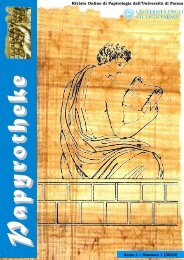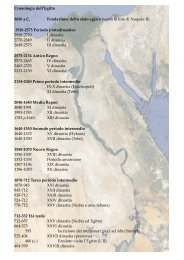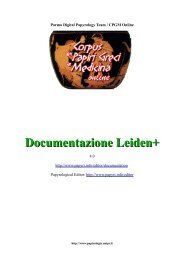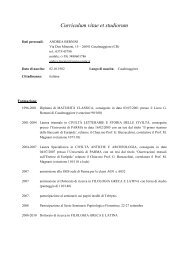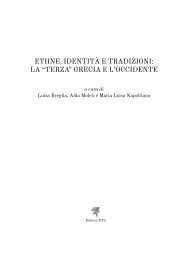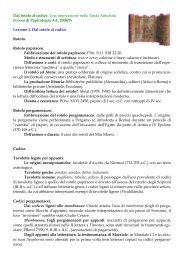The Michigan Medical Codex: P. Mich. Inv. 21 - Corso di Papirologia
The Michigan Medical Codex: P. Mich. Inv. 21 - Corso di Papirologia
The Michigan Medical Codex: P. Mich. Inv. 21 - Corso di Papirologia
Create successful ePaper yourself
Turn your PDF publications into a flip-book with our unique Google optimized e-Paper software.
124 L. C. Youtie<br />
<strong>The</strong> papyrus is me<strong>di</strong>um brown in color and the ink is dark brown, almost<br />
black.5) <strong>The</strong> scribe used a blunt pen and the resulting letters are thick and<br />
somewhat coarse. Slanting slightly to the right, they are without ligature<br />
and normally run to 18-23 letters per line. Alpha and delta often have a<br />
similar appearance, as also mu and nu; pi is made with two strokes, the<br />
second curving inward, so that it often resembles omicron. <strong>The</strong> letters are<br />
for the most part bilinear with the exception of E,p,u,w,Q and occasionally<br />
T which drop below the line. Abbreviations are infrequent: final nu at the<br />
end of a line is found as a short horizontal stroke above the prece<strong>di</strong>ng let<br />
ter,6) as in Enpr(v) in <strong>21</strong> B v.12; and oT(U6XaL) is found in B v.11 with an<br />
oblique stroke through the bottom of tau. Symbols for drahms (5), ounces (ro),<br />
and pounds (1) are employed throughout. Cf. Gal. XIX 750.7)<br />
Corrections and ad<strong>di</strong>tions are entered above the line by the scribe and<br />
also by a second hand using very black ink. <strong>The</strong> second hand has further<br />
filled all of the lower margins of <strong>21</strong> G-M with ad<strong>di</strong>tional material. This hand<br />
was in all likelihood that of the physician-owner of the codex. Writing<br />
cursively with a finer pen and employing much smaller letters and frequent<br />
abbreviations, he managed to attain as many as 8 lines of ca. 45 letters<br />
each and still keep a bottom margin of .5-1 cm.<br />
Punctuation in the body of the text is effected by a blank space within a<br />
line, high points, paragraphoi, forked paragraphoi, a blank space of one<br />
line, and indention of lines. Marginal symbols are found only in the second<br />
hand in <strong>21</strong> A, 7; H, 8-10; M, 5-10. Cf. notes ad loc.<br />
Our codex is almost entirely composed of me<strong>di</strong>cal recipes for plasters or<br />
poultices to be applied to wounds, ulcers of various kinds, carbuncles,<br />
herpes, erysipelas, ruptures of sinews or tendons, surgical incisions,<br />
fractures, etc. Ad<strong>di</strong>tional recipes of the same type were added in the deep<br />
margins at the bottom of each page from <strong>21</strong> G-M and presumably also in the<br />
missing lower margins of <strong>21</strong> A-F. Our codex is reminiscent of the collections<br />
6f recipes of the ancient me<strong>di</strong>cal writers and the further collections cited<br />
and used by those writers.8) Cf., e.g., the thirty consecutive recipes for<br />
cicatrizing plasters in Galen XIII 524-534. <strong>The</strong> first twelve recipes he took<br />
from a collection of Asclepius which included recipes attributed by Asclepius<br />
to Marcellas, Euphranor, Attalos, Pamphilos, Telamon, 9) and Moschion. <strong>The</strong><br />
5) On the use of brown metallic inks beginning in the middle of the third<br />
century A.D. see E.G.Turner, Greek Manuscripts, p.22 and footnote 3.<br />
6) For this abbreviation occurring in well-written literary works from the<br />
middle of the second century onward, see E.G.Turner, Greek Manuscripts, p.17.<br />
7) Opera omnia, Vols. I-XX (Leip-zig, 18<strong>21</strong>-1833), ed. C.G.Kuhn.<br />
8) For collections of me<strong>di</strong>cal recipes in papyri and ostraca see Pack2 2390<br />
2433 (passim), Sammelbuch VIII 9860, P.<strong>Mich</strong>. <strong>Inv</strong>. 482 (Le Monde Grec, 555),<br />
MPER N.S. XIII (passim), P.Haun. III 47.<br />
9) For the recipe of Telamon (?) in our codex see E, 9-15.



